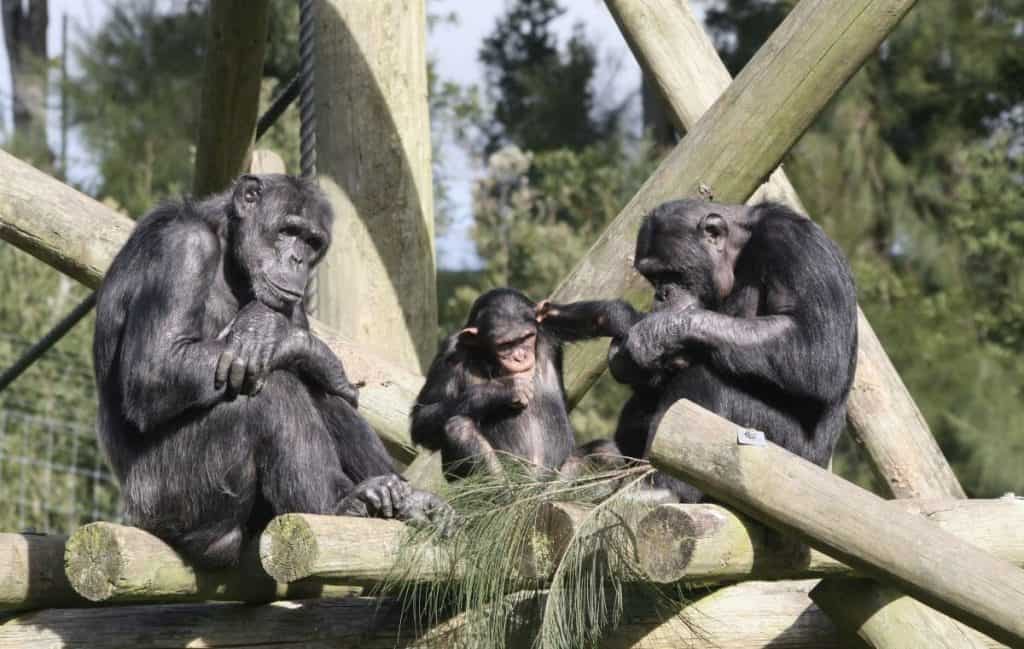Researchers use VR to study how chimps hunt for fruit


Yesterday, a Newsweek headline made an ominous claim about one of Web3’s favorite animals: “Chimpanzees Turn Ace Hunters in Virtual Reality Video Game Study.” There’s no need to take shelter — this isn’t a scenario for a prequel to Planet of the Apes – it’s about a recent scientific study exploring how chimps learn to find food between IRL and virtual reality. Turns out, they do exceptionally well.
Dr. Matthias Allritz and Dr. Josep Call from the School of Psychology and Neuroscience at the University of St. Andrews joined Dr. Francine Dolins at the University of Michigan-Dearborn in leading “the first empirical study of how chimpanzees navigate an open-field, naturalistic, virtual environment and demonstrates that chimpanzee manoeuvres in the virtual world share several key features with real-life navigation,” according to a statement from St. Andrews. The Templeton World Charity Foundation supported their research.
Voluntary primate participants in the month-long experiment included three adult male and three adult female chimpanzees from the Wolfgang Köhler Primate Research Center at Leipzig Zoo, Germany. All six chimps “had prior experience with using touchscreens, and five of them had limited experience with 3D video games.”
Together, they entered a new custom VR application called APExplorer3D – designed just for this study – to search for digital fruit amongst the first-person virtual environment of grassy hills, trees, rocks rendered in “a three-dimensional cartoon style.”
As the month wore on, the research team tasked the chimps with more and more difficult missions. They passed with flying colors, “exhibiting several cognitive processes and behavioral signatures within the virtual environment that have been predicted to guide navigation in the wild, such as learning to recognize and search for distinct landmarks and to optimize route efficiency,” the university’s statement explained. The chimps learned to recognize landmarks and re-find them from different starting locations.
“The chimpanzees in our study learned the basic game mechanics quickly and soon exhibited learning and decision-making patterns that resembled real-life navigation,” Dr. Call said. “They learned to recognize certain objects as landmarks and to orient and search for these when they could not see them. And they flexibly adapted when food availability became less predictable–though some of them were clearly faster than others.”
“Beyond the clear goal-orientation in the chimpanzees’ spatial learning, one thing that stood out to us was the remarkable speed at which the chimpanzees learned to control the virtual agent and to complete the spatial tasks,” Dr. Allitz said. “It required less training than I originally thought it would, and certainly less than many of the more traditional touchscreen tasks designed for animals.”
“Chimpanzees are the closest living relatives of humans, so understanding how they make travel decisions and how they recognize, remember and reason about travel routes does not only help us to better understand them,” he continued. “it is also critical for understanding the evolution of navigational abilities in our own species.”
Their study proves VR’s utility in unexpected areas like evolutionary biology, addressing “longstanding questions in the study of primate spatial and other forms of cognition.”

“Because of the space restrictions in zoos, studying the spatial cognition of nonhuman primates experimentally is notoriously difficult,” Dr. Allritz said. At the same time, studying animals in the wild takes time to establish trust, along with a high threshold for uncertainty.
Dr. Dolins added, “Virtual reality affords greater control over what landmarks are presented and where they are in relation to the virtual foraging sites, for example, a fruiting tree.”
“From a welfare perspective, the chimpanzees may also benefit from the cognitive enrichment that virtual environment games may provide, given their creative problem-solving and innovative abilities,” the statement continued — although this type of talk conjures Plato’s allegory of the cave.
The team at St. Andrews will publish the APExplorer 3D app on the Open Science Framework, which will allow “other researchers to directly replicate these methods and adapt them for related research questions.”
Until the next batch of findings – and overhyped headlines – come out, check out the study itself titled “Chimpanzees (Pan troglodytes) navigate to find hidden fruit in a virtual environment,” which went live last week in the academic journal Science Advances.
Read related posts:
- UK Government Plans to Launch its own NFT to Become a “Global Hub for Cryptoasset Technology”
- NVIDIA demos super-thin holographic VR glasses with 120° field-of-view potential
- Is the Metaverse Second Life with better graphics?
Disclaimer
In line with the Trust Project guidelines, please note that the information provided on this page is not intended to be and should not be interpreted as legal, tax, investment, financial, or any other form of advice. It is important to only invest what you can afford to lose and to seek independent financial advice if you have any doubts. For further information, we suggest referring to the terms and conditions as well as the help and support pages provided by the issuer or advertiser. MetaversePost is committed to accurate, unbiased reporting, but market conditions are subject to change without notice.
About The Author
Vittoria Benzine is a Brooklyn-based art writer and personal essayist covering contemporary art with a focus on human contexts, counterculture, and chaos magic. She contributes to Maxim, Hyperallergic, Brooklyn Magazine, and more.
More articles

Vittoria Benzine is a Brooklyn-based art writer and personal essayist covering contemporary art with a focus on human contexts, counterculture, and chaos magic. She contributes to Maxim, Hyperallergic, Brooklyn Magazine, and more.





















































